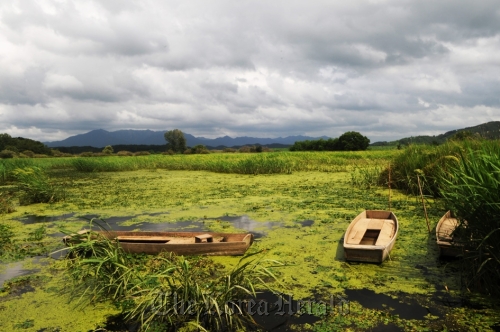National flower, Upo Wetland added to natural monuments list
By 이다영Published : Jan. 13, 2011 - 17:30
Upo Wetland, a complex of natural wetlands located in Changnyeong County, South Gyeongsang Province, and two specific trees of Rose of Sharon (Mugunghwa), Korea’s national flower, have been added to Korea’s natural monuments list, the Cultural Heritage Administration said Thursday.
Known as the largest natural wetland in the country, Upo complex includes Mokpo, Sajipo and Jokjibul wetlands. It is estimated to have been formed nearly 140 million years ago.
It is home to numerous endangered and rare species, including Taiga Bean Goose, White-naped Crane and Reeves turtle.
The site had been added to the list in 1933 and its status was reaffirmed in 1962. The site, however, lost its title in 1973 as the number of its migratory birds, swans in particular, significantly decreased.
“When Upo kept its monument title in 1962, its official name was “Baekjodoraeji,” meaning ‘where swans arrive,’” said Cho Woon-yeon, an official from natural heritage division of the Cultural Administration.
“So when the swans stopped showing up at the site, its name became meaningless and was eventually removed from the list. This time, however, we are acknowledging the entire wetland as the natural monument.”
It was last year when the government began to reconsider adding Upo to the list, as the municipal government of Changnyong County claimed the wetland deserves to be designated as UNESCO world heritage site.
Acknowledging the site’s enormous ecological significance, the government, following the request of Changnyeong, applied Upo to be potentially added to UNESCO world heritage list last year.
Roh Yong-ho, an official from Upo Wetland Ecological Park, said people who work for the wetland are excited.
Known as the largest natural wetland in the country, Upo complex includes Mokpo, Sajipo and Jokjibul wetlands. It is estimated to have been formed nearly 140 million years ago.
It is home to numerous endangered and rare species, including Taiga Bean Goose, White-naped Crane and Reeves turtle.
The site had been added to the list in 1933 and its status was reaffirmed in 1962. The site, however, lost its title in 1973 as the number of its migratory birds, swans in particular, significantly decreased.
“When Upo kept its monument title in 1962, its official name was “Baekjodoraeji,” meaning ‘where swans arrive,’” said Cho Woon-yeon, an official from natural heritage division of the Cultural Administration.
“So when the swans stopped showing up at the site, its name became meaningless and was eventually removed from the list. This time, however, we are acknowledging the entire wetland as the natural monument.”
It was last year when the government began to reconsider adding Upo to the list, as the municipal government of Changnyong County claimed the wetland deserves to be designated as UNESCO world heritage site.
Acknowledging the site’s enormous ecological significance, the government, following the request of Changnyeong, applied Upo to be potentially added to UNESCO world heritage list last year.
Roh Yong-ho, an official from Upo Wetland Ecological Park, said people who work for the wetland are excited.

“The natural monument status will definitely help promoting Upo,” Roh said. “This is encouraging especially because we are preparing a lot so Upo can be designated as UNESCO world heritage site.”
While Upo Wetland is regaining its status as a natural monument, it is the first time ever for the national flower to be added to the monuments list.
Among the two newly designated Rose of Sharon trees, one is located in Gangneung, Gangwon Province, while the other is on Baengnyeong Island in Incheon.
The tree in Gangneung is more than 100 years old, while most Rose of Sharon trees live for about 50 years.
The tree also has the circumference of 146 centimeters, which makes it the thickest Mugunghwa tree in the country. With pink petals and red pistil, the tree is one of the original kinds of Korean Rose of Sharon.
The other tree is located in front of Junghwa-dong Church on Baengnyeong Island. It is more than six meters tall, and is known to be the highest Rose of Sharon tree in Korea.
“We’ve been thinking of ways to honor our national flower over the past few years,” said Cho from the Cultural Administration.
“We thought this was one of the ways to preserve the trees better.”
In addition to Upo Wetland and the Rose of Sharon trees, two old trees ― a tangerine tree and a Korean quince ― have been added to the list for their historical significance.
By Claire Lee (clairelee@heraldcorp.com)












![[Today’s K-pop] BTS pop-up event to come to Seoul](http://res.heraldm.com/phpwas/restmb_idxmake.php?idx=644&simg=/content/image/2024/04/17/20240417050734_0.jpg&u=)




![[KH Explains] Hyundai's full hybrid edge to pay off amid slow transition to pure EVs](http://res.heraldm.com/phpwas/restmb_idxmake.php?idx=652&simg=/content/image/2024/04/18/20240418050645_0.jpg&u=20240418181020)

![[Today’s K-pop] Zico drops snippet of collaboration with Jennie](http://res.heraldm.com/phpwas/restmb_idxmake.php?idx=642&simg=/content/image/2024/04/18/20240418050702_0.jpg&u=)